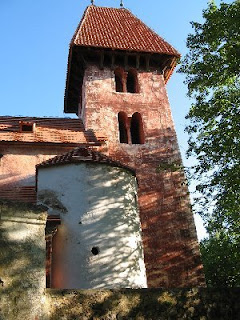 I promised to blog about scything a fortnight ago or so. There was a danger at that time that I would turn into a scything bore, as I was much taken with my new found skill (although skill is probably too good a word for it).
I promised to blog about scything a fortnight ago or so. There was a danger at that time that I would turn into a scything bore, as I was much taken with my new found skill (although skill is probably too good a word for it).Faced with a large orchard, which has been allowed to go wild over several years, I had employed over the last few years a number of people to scythe the grass. With the exception of the first year, when I had employed a group of locals to have a scything party, the orchard has always resisted being completely cut. This year I decided I would have a go.
I bought a scythe and sharpening stone and started. I was pathetic, my technique was clearly rotten, and, as I later found out, by trying to cut the shorter less thick grass I was attempting to cut a section which was less conducive to scything. So what to do? Well thank goodness for Youtube, there were a number of videos by scythe advocates showing me how to do it. My first reaction was "I'll never do that", but on watching and rewatching I began to understand the errors of my ways.
I also got some good advice from a Czech friend, who told me the best time to scythe was early in the morning when the sap was up in the grass and before the midday sun. So I started rising at 6 and getting four hours in before the day started. I managed to mow all the areas under the fruit trees and paths to them as well as the area at the back of the house and in the yard, approximately one third of the orchard.
 I actually started to enjoy it. There is great pleasure to be had as a swathe of nettles bites the dust. The exercise is good for the muscles in the arms, legs and waist and indeed for the heart. I could think about other things as I mowed and I found that the orchard birds came to see me as part of the orchard fauna and so ignored me as I scythed.
I actually started to enjoy it. There is great pleasure to be had as a swathe of nettles bites the dust. The exercise is good for the muscles in the arms, legs and waist and indeed for the heart. I could think about other things as I mowed and I found that the orchard birds came to see me as part of the orchard fauna and so ignored me as I scythed.After a fortnight of showers and sun of course I need to start all over again, as I want to keep the growth down. But that is not the point, I will never turn the yard and orchard into a neat lawn and I don't want to. What I want is to mow enough and at the right times of year (once in early summer and once in the Autumn) to create an old-fashioned haymeadow, to keep the more rigorous weeds down and to allow the wildflowers to take over.
 On my mother's side my family has worked the land for generations, and it gives me a certain amount of satisfaction to gain a skill that my ancestors would have had in abundance. I imagine my lovely Uncle John and the granddad I never knew watching me, and commenting on my rubbish technique and what was that scythe I was using (I have an Austrian type not the British one here). I am sure Uncle John is just itching to get in there and show me what's what.
On my mother's side my family has worked the land for generations, and it gives me a certain amount of satisfaction to gain a skill that my ancestors would have had in abundance. I imagine my lovely Uncle John and the granddad I never knew watching me, and commenting on my rubbish technique and what was that scythe I was using (I have an Austrian type not the British one here). I am sure Uncle John is just itching to get in there and show me what's what.











